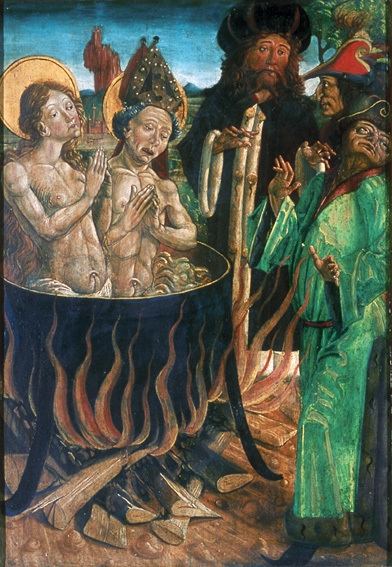Name Cyprian Justina | ||
 | ||
Feast September 26,October 2 (Eastern Orthodox Church) | ||
Sts cyprian and justina paraklesis
Saints Cyprian and Justina are honored in the Catholic Church, Eastern Orthodox Church and Oriental Orthodoxy as Christians of Antioch, who in 304, during the persecution of Diocletian, suffered martyrdom at Nicomedia (modern-day İzmit, Turkey) on September 26.
Contents
- Sts cyprian and justina paraklesis
- Saints cyprian and justina
- Origin
- Legend
- Veneration and liturgical celebration
- Patronage
- In popular culture
- References
Saints cyprian and justina
Origin
The story must have arisen as early as the 4th century, as it is mentioned both by St. Gregory Nazianzen and Prudentius; both, nevertheless, have confounded Cyprian with St. Cyprian of Carthage, a mistake often repeated. The attempt has been made to find in Cyprian a mystical prototype of the Faustian legend. The legend is given in Greek and Latin in Acta SS. September, VII. Ancient Syriac and Ethiopic versions of it have been published.
Legend
Cyprian, known by the title of the magician, to distinguish him from Cyprian, bishop of Carthage, received a liberal education in his youth, and particularly applied himself to astrology; after which he traveled for improvement through Greece, Egypt, India, etc. Cyprian was a magician in Antioch and dealt in sorcery.
Justina of Antioch is a Christian saint, known for converting Cyprian, a pagan magician of Antioch. She is said to have been martyred in the year 304 AD. Justina was said to have been a young woman who took private vows of chastity and was killed during the persecutions of the Roman emperor Diocletian.
The outline of the legend or allegory is found with diffuse descriptions and dialogues in the unreliable "Symeon Metaphrastes" and was made the subject of a poem by Empress Aelia Eudocia.
A would-be suitor sought a magic spell to induce Justina to marry him. The charms had no effect on Justina, who spent her time in prayer and fasting. Brought to despair, Cyprian made the sign of the cross himself and in this way was freed from the toils of Satan. He was received into the Church, was made pre-eminent by miraculous gifts, and became in succession deacon, priest and, finally, bishop, while Justina became the abbess of a convent. It is, however, certain that no Bishop of Antioch bore the name of Cyprian.
She is mentioned in Foxe's Book of Martyrs. It was under the 10th Persecution in 303 AD while Diocletian was Emperor of Rome. It says:
" In the course of time he [Cyprian] became acquainted with Justina, a young lady of Antioch, whose birth, beauty, and accomplishments, rendered her the admiration of all who knew her. A pagan gentleman applied to Cyprian, to promote his suit with the beautiful Justina; this he undertook, but soon himself converted, burnt his books of astrology and magic, received baptism, and felt animated with a powerful spirit of grace. The conversion of Cyprian had a great effect on the pagan gentleman who paid his addresses to Justina, and he in a short time embraced Christianity. During the persecutions of Diocletian, Cyprian and Justina were seized upon as Christians, the former was torn with pincers, and the latter chastised; and, after suffering other torments, both were beheaded."
During the Diocletian persecution, both were seized and taken to Damascus, where they were tortured. As their faith never wavered, they were brought before Diocletian at Nicomedia, where at his command they were beheaded on the bank of the river Gallus. The same fate befell a Christian, Theoctistus, who observing Cyprian's faith, declared himself a Christian.
After the bodies of the saints had lain unburied for six days, they were taken by Christian sailors to Rome, where they were interred on the estate of a noble lady named Rufina and later were entombed in Constantine's basilica.
Veneration and liturgical celebration
Their feast day appeared in the calendar of Roman Rite celebrations from the thirteenth century until 1969, when it was removed because of the lack of historical evidence of their existence. Their names were also removed from the subsequent (2001) revision of the Roman Martyrology, the official but professedly incomplete list of saints recognized by the Roman Catholic Church. The Roman Martyrology, however, includes five saints called Cyprian and two named Justina. Some traditionalist Catholics continue to observe pre-1970 versions of the Roman Calendar.
Charles Borromeo dedicated the chapel of the Collegio Borromeo (built in 1561) in Pavia to her.
Saint Justina's remains rest in the Church of Saint Anthony, in Lisbon, after being transferred from St. Lawrence's Cemetery in Rome by Pope Pius VI in 1777.
Patronage
Saint Justina is, after Saint Mark, the patroness of Venice.
In popular culture
The Spanish author, Pedro Calderón de la Barca, took the story as the basis of a drama: El mágico prodigioso. In 2005, American author Tono Rondone published a novel, The Martyrs, which is a continuation of this tradition.
The Great Book of Saint Cyprian is full of prayers and spells, and is widely sold in the Portuguese- and Spanish-speaking world.
Cyprianus is a popular name for a grimoire in Scandinavian folklore.
